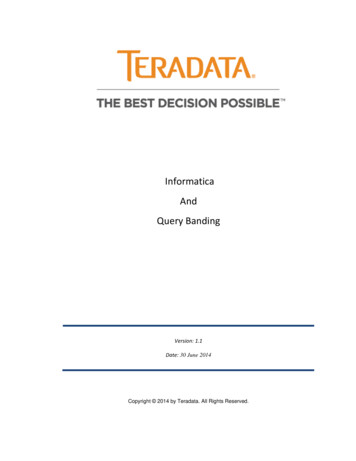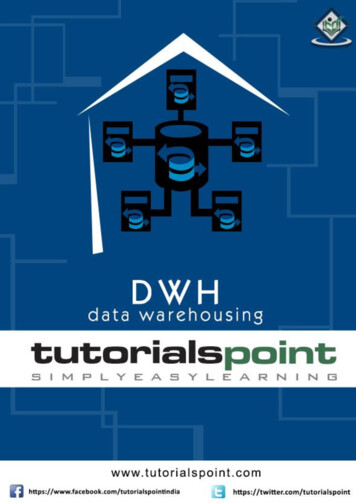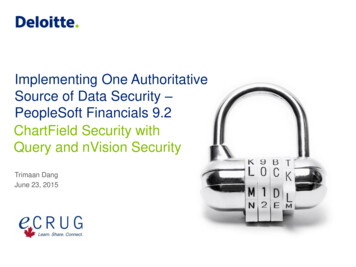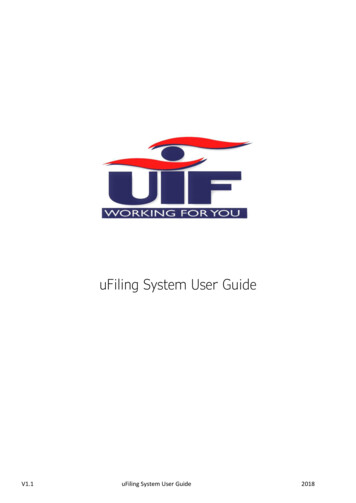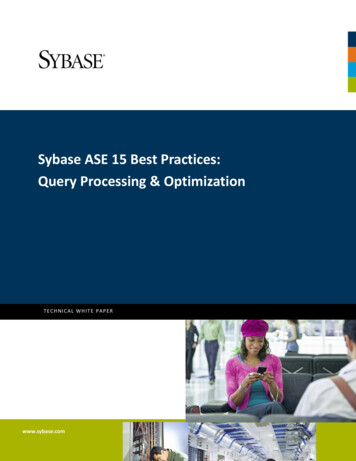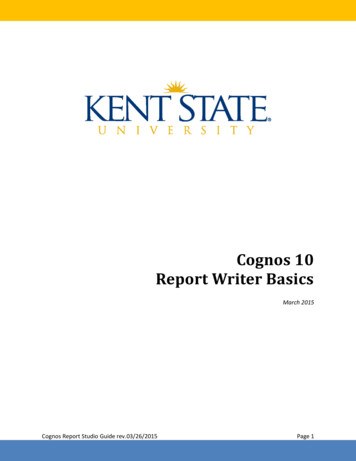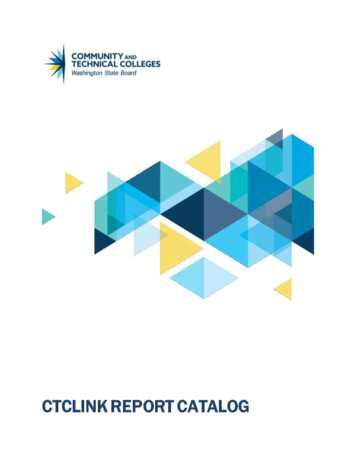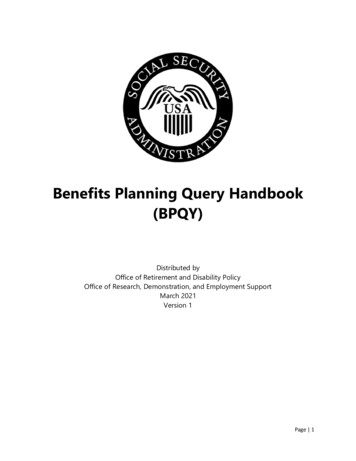
Transcription
Benefits Planning Query Handbook(BPQY)Distributed byOffice of Retirement and Disability PolicyOffice of Research, Demonstration, and Employment SupportMarch 2021Version 1Page 1
Table of ContentsCONTENTSIntroduction . 3How to Request a BPQY . 3Beneficiary Requests . 3Third Party Requests. 3The Red Book . 4Understanding the BPQY . 4Example of BPQY Cover letter . 5Example of BPQY Statement. 6Definitions of Each Field . 8SSN . 8Record. 8Cash . 8Others Paid on the Record. 9Medical Reviews . 9Representation . 10Health Insurance. 10SSI Work Exclusions . 11SSDI Work Activity . 11Demonstration Project Information . 12Earnings Record . 12Exhibit – Consent for Release of Information Form (SSA-3288) . 13Page 2
INTRODUCTIONThe Benefits Planning Query (BPQY) is part of the Social Security Administration’s (SSA) effortsto inform Social Security Disability Insurance (SSDI) beneficiaries and Supplemental SecurityIncome (SSI) recipients about their disability benefits and the use of work incentives. A BPQYstatement contains detailed information about the status of a beneficiary's disability cashbenefits, scheduled medical reviews, health insurance, and work history. In essence, the BPQYprovides a snapshot of the beneficiary's benefits and work history as stored in SSA's electronicrecords.The BPQY is a tool used by Area Work Incentive Coordinators (AWIC), the Plan to Achieve SelfSupport (PASS) Cadre members, advocates, beneficiaries, and other individuals. Theinformation contained in a BPQY provides customized information on SSA’s employmentsupport programs to beneficiaries with disabilities who want to start or keep working. Analysisof a beneficiary’s disability and work status is the first step when planning a successful return towork.HOW TO REQUEST A BPQYWe give the BPQY statement to beneficiaries and their representatives upon request withproper authorization.BENEFICIARY REQUESTSBeneficiaries can request a BPQY by contacting their local office, or calling 1-800-772-1213 from8 a.m. to 7 p.m., Monday through Friday. People who are deaf or hard of hearing may call ourtoll-free TTY/TDD number, 1-800-325-0778, between 8 a.m. and 7 p.m., Monday throughFriday. A telephone representative will either help you themselves, or put you in contact withyour local office. Many local telephone directories list local offices under “Social Security.”If you have internet access, use the Social Security Office Locator on our home page, SocialSecurity Online, at https://www.ssa.gov. Enter your postal ZIP code and we will give you theaddress, telephone number, and directions to your local office.THIRD PARTY REQUESTSA signed consent form is required when the BPQY will be sent to someone other than thebeneficiary (for example, to the beneficiary’s Representative Payee, Authorized Representative,Page 3
advocates, benefits counselors, or an organization). These individuals/organizations mustsubmit a Consent for Release of Information form (SSA-3288) that has been appropriatelysigned by the beneficiary (See Exhibit). The Consent for Release of Information is needed torelease information from Social Security records, and must contain the beneficiary’s SocialSecurity Number (SSN) or the Claim Number. THE CONSENT FORM REQUIRES A WETSIGNATURE FROM THE BENEFICIARY.THE RED BOOKThe Red Book (Publication No. 64-030) is a general reference tool designed to provide aworking knowledge of the employment support provisions for individuals with disabilities underthe SSDI and SSI programs. The Red Book is primarily for educators, advocates, rehabilitationprofessionals, and counselors who serve persons with disabilities. We also expect thatapplicants and beneficiaries will use it as a self-help guide. Its purpose is to provide a workingknowledge or our work incentives so that users can advise individuals with disabilitiesappropriately and recognize when to seek case-specific guidance from SSA.The Red Book is available online at: www.socialsecurity.gov/redbook/. En Espanol at: El LibroRojo del 2020 (ssa.gov). Alternative media is also available (Braille, audio CD, or enlarged print)at: Request for Publications in Alternative Media SSA .UNDERSTANDING THE BPQYThe BPQY is designed to provide information based on SSA records to help a successful returnto work effort. Any plan for returning to work should begin with knowing existing disabilitystatus and having an understanding of how work will impact disability benefits. A BPQY is anexcellent starting point.The following pages show an example of a BPQY Cover Letter and BPQY statement, with anexplanation of the information contained in each section.Page 4
EXAMPLE OF BPQY COVER LETTERPage 5
EXAMPLE OF BPQY STATEMENTPage 6
Page 7
DEFINITIONS OF EACH FIELDSSNBPQY gives the last four of the SSN of the individual who is the subject of the statement, even ifbenefits are being paid from a parent or spouse’s record under a different SSN.RECORDThe first column provides the categories broken into sections for Cash, Medical Reviews,Representation, Health Insurance, SSI work Exclusions, SSDI Work Activity, and DemonstrationProject Information. We provide the SSI recorded earnings in monthly totals. If available, wealso provide the posted SSDI monthly earnings for the last five years.CASHUnder the cash category, this section details the type and status of benefits and paymentamounts.TYPE OF BENEFITShows the type of benefit received. NOTE: In SSDI cases, a beneficiary may receive benefits onmore than one record (SSN), but only the current benefit is reported on the BPQY.POSSIBLE SSDI ENTRIESDisabled Worker, Disabled Adult Child, Disabled Widow, Disabled Widower, DisallowedClaim, Denied Claim-Medical DenialPOSSIBLE SSI ENTRIESDisabled Individual, Disabled Spouse, Disabled Child, Blind Individual, Blind Spouse, BlindChild, Disabled Student, Blind StudentCURRENT STATUSA beneficiary may be in a current pay status (getting a check), suspended, or terminatedentitlement.STATUTORY BLINDNESSYes means that SSA has determined that the beneficiary’s visual impairment meets thedefinition of Statutory Blindness, under the Social Security Act for SSDI/SSI benefit purposes.The substantial gainful activity (SGA) level is higher for statutory blindness than for other typesof disabilities.DATE OF DISABILITY ONSETThe most recent medical disability onset date established by SSA.DATE OF ENTITLEMENTThe most recent date of entitlement to SSDI benefits and/or the most recent date of eligibilityfor SSI. Earlier periods of entitlement and/or eligibility are not displayed.Page 8
FULL AMOUNTThe full amount of the monthly cash benefit before any deductions or reductions for Medicarepremiums, overpayment collections, etc.Possible entries are: Monthly cash benefit amount, suspended, deferred, or terminated.The SSI full amount includes any federally administered state supplement, but does not includeany state administered state supplement payment.NET AMOUNTThe amount of cash benefits paid by check or electronic funds transfer to the beneficiary’sfinancial institution. This is the cash amount received after deducting any Medicare premium,overpayment recovery, garnishment, etc. from the Full Amount.Others Pai d on the RecordIndicates if other people are entitled to benefits on this record. Other beneficiary’s cash ormedical benefits may be affected when the disabled individual’s work activity results intermination of cash benefits. If a disabled adult child/widow(er) benefit is listed as a "Type ofBenefit,” other beneficiaries on this record will not have their benefits reduced due to the workactivity of the disabled adult child/widow(er), but others’ benefits may increase.TOTAL FAMILY CASH BE NEFITSThe full amount of cash benefits paid to the disability beneficiary and other entitled familymembers on this record for SSDI. Not Applicable will print under the SSI column since SSI is anindividual entitlement.OVERPAYMENT BALANCEThe current balance of any outstanding monies owed to SSA for incorrect cash payments.MONTHLY AMOUNT WITHHELDThe amount of cash benefits that SSA is withholding to apply towards a past overpayment ofbenefits.MEDICAL REVIEWSNEXT MEDICAL REVIEWThe date scheduled to review the beneficiary’s medical condition. If unknown is displayed, nomedical review is scheduled.MEDICAL RE-EXAM CYCLEThere are three types of medical review diaries. The letter codes represent the reason forestablishing a periodic review diary of less than 3 years, while the numeric codes representperiodic review diaries of 3 years or longer. Possible entries are:Page 9
CodeA thru U DescriptionPeriodic review diary of less than 3 years (medical improvement isexpected)3 3-year periodic review diary (non-permanent disability)5 5-year periodic review diary (permanent disability)7 7-year periodic review diary (permanent disability)NOTE: There may be different periodic review diaries and scheduled dates for SSDI and SSI. The entries will showthat the medical diary is deferred due to Ticket to Work.REPRESENTATIONREPRESENTATIVE PAYEEA no indicates that the disabled beneficiary receives cash benefits directly; a yes means thathe/she has a Representative Payee.AUTHORIZIED REPRESENTATIVEA no indicates that the disabled beneficiary does not have an authorized representative; a yesmeans that he/she has appointed an Authorized Representative.HEALTH INSURANCETYPEShows the type of Medicare and/or Medicaid health insurance entitlement and/or eligibility onSSA’s records. It includes Medicare Part A (hospital), Part B (medical), and Medicaid eligibilitystatus under SSI.STARTDate current coverage began.STOPDate coverage ended.NOTE: When an SSDI beneficiary reaches age 65, Medicare converts from Medicare based on disability to Medicarebased on age. This occurs even though cash benefits will not convert to retirement benefits until full retirement age.In these situations, the BPQY incorrectly displays a MEDICARE stop date effective with the month of the 65thbirthday.BUY-INShows yes or no for Parts A & B. A yes means the state of residency pays the premium for thisbeneficiary. No means the premium is either deducted from his or her monthly check or paid bypremium billing.Page 10
Part A is premium free except for extended Medicare eligibility through Medicare for theWorking Disabled.CAUTION: There are sources of eligibility to Medicaid that are unknown to SSA. If an SSI recipient resides in a statethat allows Medicaid eligibility with SSI eligibility (i.e., a 1634 state), the BPQY will show the Medicaid eligibilityinformation. For all other situations (i.e., 209b states or SSI criteria states), verify Medicaid eligibility through thelocal or state Medicaid Agency.SSI WORK EXCLUSIONSDetails SSI Work Incentives that exclude earned income from the calculation of the SSI paymentamount.Blind Work Expenses, Impairment-Related Work Expenses, Student Earned Income Exclusions,and PASS Exclusion. If a work exclusion does not apply, the entry will be blank. If a workexclusion applies, the dollar amount of the exclusion and the month when it was excluded willbe provided.NOTE: A Plan to Achieve Self-Support (PASS) can also result in an exclusion of unearned income.SSDI WORK ACTIVITYDetails a beneficiary’s work activity as recorded in SSDI electronic records.TRIAL WORK MONTHS Start: Month and year of the first month of Trial Work Period (TWP)End: Month and year of last month of TWPUsed: Total number of months of the TWP completedThis information is based on the most recent work continuing disability review (CDR)determination. In some cases, a work CDR may be pending or overdue, so the informationprovided may not be current. If you suspect that this information is outdated or incorrect,contact a Social Security representative as soon as possible.MONTH OF CESSATIONThe first month after the TWP that, based on SSA records, the beneficiary performed SGA.Payment of cash benefits after the cessation month depends on the beneficiary’s work activity.The beneficiary is entitled to benefits for that month, and the next two months (grace period).It is possible for a beneficiary to have a cessation date but continue receiving benefits if thegross monthly earnings during the extended period of eligibility are not SGA.Page 11
CURRENT SGA LEVELThe SGA amount appropriate for this beneficiary. The current SGA amount for beneficiarieswith disabilities other than blindness and for individuals with blindness may be found in TheRed Book at http://www.ssa.gov/redbook/eng/main.htm. SGA amounts are annually inJanuary.LAST WORK ACTIONThe last work action review represents either the last work review decision date or the date westarted a current review.DEMONSTRATION PROJEC T INFORMATIONProvides information about any applicable demonstration project such as a Benefit OffsetNational Demonstration.EARNINGS RECORDProvides a synopsis of work-related earnings as shown in our records.SSI RECORDED EARNINGS (MONTHLY)The right columns display monthly earnings for the most recent 2 years posted on the SSIrecord. Verified earnings have a V code and estimated earnings have an E code.POSTED SSDI MONTHLY EARNINGS (LAST FIVE YEARS)Provides a listing of the last five years of monthly SSDI earnings.GROSS WAGESThe monthly earnings for the five most recent years as posted on the SSDI record.GROSS VERIFICATIONSY indicates earnings have been verified. If gross earnings are unverified, they are coded with anN.TOTAL COUNTABLE EARNINGSThe total amount of earnings after deductions for subsidies, special conditions, unincurredbusiness expenses, and impairment-related work expenses.Page 12
EXHIBIT – CONSENT FOR RELEASE O F INFORMATION FORM (SSA-3288)Page 13
We give the BPQY statement to beneficiaries and their representatives upon request with proper authorization. BENEFICIARY REQUESTS Beneficiaries can request a BPQY by contacting their local office, or calling 1-800-772-1213 from 8 a.m. to 7 p.m., Monday through Friday. People who are deaf or hard of hearing may call our
